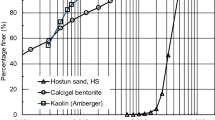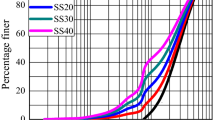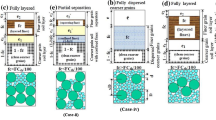Abstract
Sand-fines mixtures are widely distributed in the world. However, the effect of fines on the liquefaction strength of sand-fines mixtures is still in issue. A series of undrained cyclic triaxial test was carried out to study the liquefaction behaviour of sand-fines mixtures. The influences of the plasticity of fines (PI), fines content (FC), global void ratio (e), relative density (Dr) were considered. The results show that the traditional liquefaction criterion of pure sand can be applied to the sand-fines mixtures with plastic fines. The cyclic resistance ratio (CRR) of the mixtures decreases and then stabilizes with increasing FC when the samples are prepared at a constant Dr. However, the CRR decreases and then increases with increasing FC when the samples are prepared at a constant e. The threshold fines content (FCth) also varies. The CRR of the mixtures increases with increasing Dr. A single Dr or e cannot describe the dense state of the mixture effectively. A new index, Dr/e, is proposed in this study to describe the dense state of the mixtures. A semi-empirical model is proposed to evaluate the CRR of the mixtures using the parameters of Dr/e, FC and PI of the fines based on the back analysis method. The applicability of the model is verified by the test data from this study and other scholars. In addition, the parameters of Dr/e, FC and PI of the fines can be obtained from basic geotechnical tests, which is convenient for the application of the model.













Similar content being viewed by others
Data Availability
Enquiries about data availability should be directed to the authors.
References
Akbarimehr D, Fakharian K (2021) Dynamic shear modulus and damping ratio of clay mixed with waste rubber using cyclic triaxial apparatus. Soil Dyn Earthq Eng 140:106435
Akbarimehr D, Hosseini SMMM (2022) Elasto-plastic characteristics of the clay soil mixed with rubber waste using cyclic triaxial test results. Arab J Geosci 15(14):1–14
Ali ET, Abouzar S, Hesham EN (2016) Cyclic resistance and liquefaction behavior of silt and sandy silt soils. Soil Dyn Earthq Eng 83:98–109
Amini F, Qi GZ (2000) Liquefaction testing of stratified silty sands. J Geotech Geoenviron Eng ASCE 126(3):208–217
ASTM D4253 (2014) Standard test methods for maximum index density and unit weight of soils using a vibratory table. ASTM International, West Conshohocken, PA
ASTM D4254 (2014) Standard test methods for minimum index density and unit weight of soils and calculation of relative density. ASTM International, West Conshohocken, PA
ASTM D5311D/5311M (2013) Standard test method for load controlled cyclic triaxial strength of soil. ASTM International, West Conshohocken, PA
Baghbani A, Costa S, Faradonbeh RS, Soltani A, Baghbani H (2023) Modeling the effects of particle shape on damping ratio of dry sand by simple shear testing and artificial intelligence. Appl Sci 13(7):4363
Bahadori H, Ghalandarzadeh A, Towhata I (2008) Effect of non plastic silt on the anisotropic behavior of sand. Soils Found 48(4):531–545
Casagrande A (1975) Liquefaction and cyclic deformation of sands: a critical review. In: Proceedings of the Fifth Pan-American Conference on Soil Mechanics and Foundation Engineering, Buenos Aires, Argentina
Chang NY, Yeh ST, Kaufman LP (1982) Liquefaction potential of clean and silty sands. In: Proceedings of the Third International Earthquake Microzonation Conference, vol 2. Seattle, USA, pp 1017–1032
Chen GX, Wu Q, Zhao K, Shen ZF, Yang J (2020) A binary packing material-based procedure for evaluating soil liquefaction triggering during earthquakes. J Geotech Geoenviron Eng ASCE 146(6):04020040
Chen GX, Wu Q, Sun T, Zhao K, Zhou EQ, Xu LY, Zhou YG (2021) Cyclic behaviors of saturated sand-gravel mixtures under undrained cyclic triaxial loading. J Earthq Eng 25(4):756–789
Chien LK, Oh YN (2002) Influence of fines content and initial shear stress on dynamic properties of hydraulic reclaimed soil. Can Geotech J 39(1):242–253
Cubrinovski M, Rees S, Bowman E (2010) Effects of non-plastic fines on liquefaction resistance of sandy soils. In: Garevski M, Ansal A (eds) Earthquake engineering in Europe. Springer, Dordrecht, pp 125–144
Dash HK, Sitharam TG, Baudet BA (2010) Influence of non-plastic fines on the response of a silty sand to cyclic loading. Soils Found 50(5):695–704
Dezfulian H (1984) Effects of silt content on dynamic properties of sandy soils. In: Proceedings of the Eighth World Conference on Earthquake Engineering, California, USA, pp 63–70
Eslami A, Akbarimehr D (2021) Failure analysis of clay soil-rubber waste mixture as a sustainable construction material. Constr Build Mater 310:125274
Ghahremani M, Ghalandarzadeh A (2006) Effect of plastic fines on cyclic resistance of sands. In: Proceedings of GeoShanghai International Conference, Shanghai, China, pp 406–412
Gu XQ, Yang J, Huang MS, Gao GY (2015) Bender element tests in dry and saturated sand: signal interpretation and result comparison. Soils Found 55(5):951–962
Hsiao DH, Phan VTA, Hsieh YT, Kuo HY (2015) Engineering behavior and correlated parameters from obtained results of sand-silt mixtures. Soil Dyn Earthq Eng 77:137–151
Jahangard H, Hosseini SMMM, Ebadi T, Akbarimehr D (2022) Effect of gas oil contamination on dynamic geotechnical properties of clay-sand mixtures. Arab J Geosci 15(3):1–16
Karakan E, Tanrinian N, Sezer A (2019) Cyclic undrained behavior and post liquefaction settlement of a nonplastic silt. Soil Dyn Earthq Eng 120(MAY):214–227
Karim ME, Alam MdJ (2014) Effect of non-plastic silt content on the liquefaction behavior of sand-silt mixture. Soil Dyn Earthq Eng 65:142–150
Lade PV, Yamamuro JA (1997) Effects of nonplastic fines on static liquefaction of sands. Can Geotech J 34(6):918–928
Liu JG (2020) Influence of fines contents on soil liquefaction resistance in cyclic triaxial test. Geotech Geol Eng 38:4735–4751
Polito CP, Martin JR II (2001) Effects of nonplastic fines on the liquefaction resistance of sands. J Geotech Geoenviron Eng ASCE 127(5):408–415
Rahman MM, Lo SR, Gnanendran CT (2008) On equivalent granular void ratio and steady state behaviour of loose sand with fines. Can Geotech J 45(10):1439–1456
Rahman MM, Baki MAL, Lo SR (2014) Prediction of undrained monotonic and cyclic liquefaction behavior of sand with fines based on the equivalent granular state parameter. Int J Geomech 14(2):254–266
Salgado R, Bandini P, Karim A (2000) Shear strength and stiffness of silty sand. J Geotech Geoenviron Eng ASCE 126(5):451–462
Seed HB, Lee KL (1966) Liquefaction of saturated sands during cyclic loading. J Soil Mech Found Div 92(6):105–134
Sitharam TG, Dash HK, Jakka RS (2013) Postliquefaction undrained shear behavior of sand-silt mixtures at constant void ratio. Int J Geomech 13(4):421–429
Thevanayagam S, Martin GR (2002) Liquefaction in silty soils-screening and remediation issue. Soil Dyn Earthq Eng 22(9–12):1035–1042
Ueng TS, Sun CW, Chen CW (2004) Definition of fines and liquefaction resistance of Maoluo River soil. Soil Dyn Earthq Eng 24(9–10):745–750
Wood FM, Yamamuro JA, Lade PV (2008) Effect of depositional method on the undrained response of silty sand. Can Geotech J 45(11):1525–1537
Xenaki VC, Athanasopoulos GA (2003) Liquefaction resistance of sand-silt mixtures: an experimental investigation of the effect of fines. Soil Dyn Earthq Eng 23(3):1–12
Xu LY, Zhang JZ, Cai F, Chen WY, Xue YY (2019) Constitutive modeling the undrained behaviors of sands with non-plastic fines under monotonic and cyclic loading. Soil Dyn Earthq Eng 123:413–424
Yang J, Sze HY (2011) Cyclic behaviour and resistance of saturated sand under non-symmetrical loading conditions. Geotechnique 61(1):59–73
Zlatovic S, Ishihara K (1997) Normalized behavior of very loose non-plastic soils: effects of fabric. Soils Found 37(4):47–56
Acknowledgements
The work presented in this paper is supported by the Natural Science Foundation of China (Grant No. 52208351) and the start-up foundation of the Nanyang Institute of Technology (Grant No. NGBJ-2020-08).
Author information
Authors and Affiliations
Corresponding author
Ethics declarations
Conflicts of interest
The authors declare that they have no conflicts of interest.
Additional information
Publisher's Note
Springer Nature remains neutral with regard to jurisdictional claims in published maps and institutional affiliations.
Rights and permissions
Springer Nature or its licensor (e.g. a society or other partner) holds exclusive rights to this article under a publishing agreement with the author(s) or other rightsholder(s); author self-archiving of the accepted manuscript version of this article is solely governed by the terms of such publishing agreement and applicable law.
About this article
Cite this article
Cheng, K., Zhang, Y. A Cyclic Resistance Ratio Model of Sand-Fines Mixtures Based on Cyclic Triaxial Test. Geotech Geol Eng 42, 1021–1033 (2024). https://doi.org/10.1007/s10706-023-02602-6
Received:
Accepted:
Published:
Issue Date:
DOI: https://doi.org/10.1007/s10706-023-02602-6




